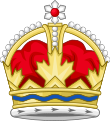| Monarchy of Canada |
|---|
 |
| This article is part of a series |
 |
|---|

The monarchy of Canada forms the core of each Canadian provincial jurisdiction's Westminster-style parliamentary democracy, being the foundation of the executive, legislative, and judicial branches of government in each province.[1][2][3] The monarchy has been headed since September 8, 2022 by King Charles III who as sovereign is shared equally with both the Commonwealth realms and the Canadian federal entity. He, his consort, and other members of the Canadian royal family undertake various public and private functions across the country. He is the only member of the royal family with any constitutional role.
Royal assent and the royal sign-manual are required to enact laws, letters patent, and Orders in Council. The Constitution Act, 1867, leaves the monarch's direct role in the provinces in question and many royal duties in these regions are specifically assigned to the sovereign's provincial viceroys, known as lieutenant governors, who are appointed by the King's federal representative, the governor general.[4] Further, within the conventional stipulations of constitutional monarchy, the Crown's direct participation in any of these areas of governance is limited, with most related powers entrusted for exercise by the elected parliamentarians, the appointed ministers of the Crown generally drawn from amongst them, and the judges and justices of the peace.[5] The Crown today primarily functions as a guarantor of continuous and stable governance and a nonpartisan safeguard against the abuse of power,[5][6][7] the sovereign acting as a custodian of the Crown's democratic powers and representing the "power of the people above government and political parties."[8][9]
In all provinces, the monarchy's roots lie in the British Crown, while in some, mostly in Eastern Canada, the French Crown also had influence. Over the centuries, the institution throughout the country has evolved to become a distinctly Canadian one,[10] represented by unique symbols for each province.
- ^ Privy Council Office (2008). Accountable Government: A Guide for Ministers and Ministers of State - 2008. Ottawa: Queen's Printer for Canada. p. 49. ISBN 978-1-100-11096-7. Archived from the original on 24 September 2009. Retrieved 17 May 2009.
- ^ Victoria (29 March 1867). "Constitution Act, 1867". III.9, V.58. Westminster: Queen's Printer. Retrieved 15 January 2009.
- ^ Forsey, Eugene (2005). How Canadians Govern Themselves (PDF) (6th ed.). Ottawa: Queen's Printer for Canada. pp. 1, 34. ISBN 978-0-662-39689-5. Retrieved 14 May 2009.
- ^ Victoria 1867, V
- ^ a b MacLeod, Kevin S. (2008). A Crown of Maples (PDF) (1st ed.). Ottawa: Queen's Printer for Canada. p. 16. ISBN 978-0-662-46012-1.
- ^ Roberts, Edward (2009). "Ensuring Constitutional Wisdom During Unconventional Times" (PDF). Canadian Parliamentary Review. 23 (1). Ottawa: Commonwealth Parliamentary Association: 15. Archived from the original (PDF) on 26 April 2012. Retrieved 21 May 2009.
- ^ MacLeod 2008, p. 20
- ^ Cabinet Secretary and Clerk of the Executive Council (April 2004). "Executive Government Processes and Procedures in Saskatchewan: A Procedures Manual" (PDF). Regina: Queen's Printer for Saskatchewan. p. 10. Retrieved 30 July 2009.
- ^ Cabinet Secretary and Clerk of the Executive Council 2004, p. 9
- ^ MacLeod 2008, pp. 2–3, 39
